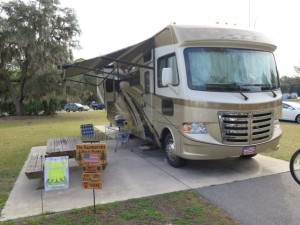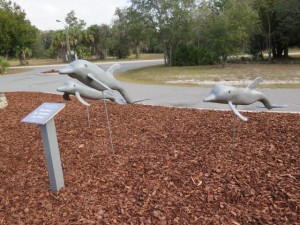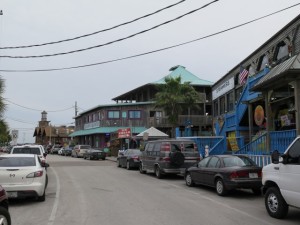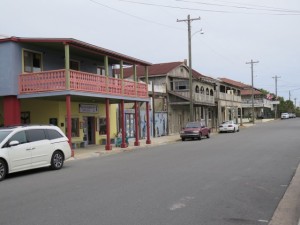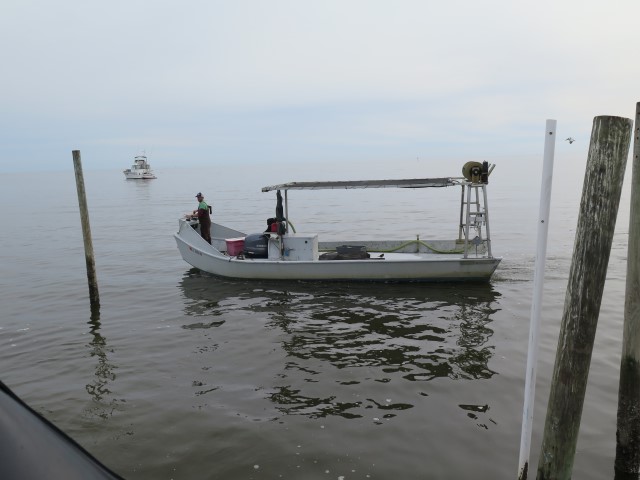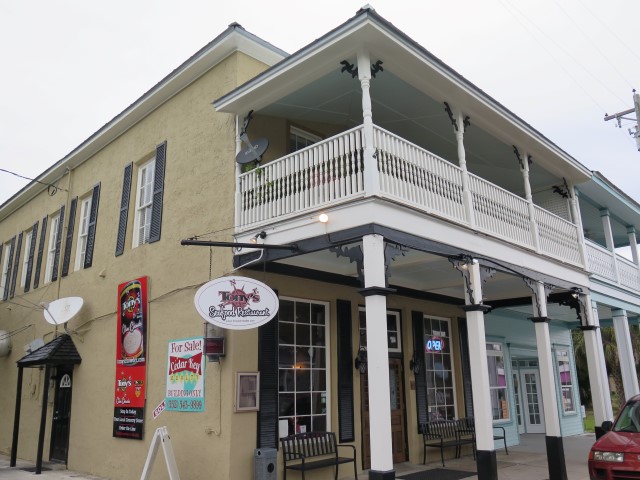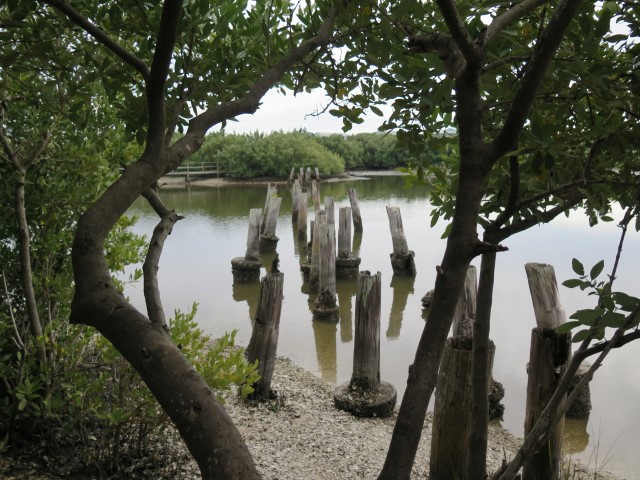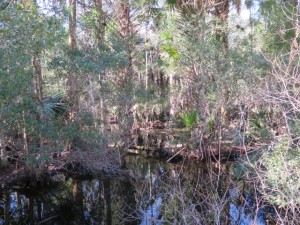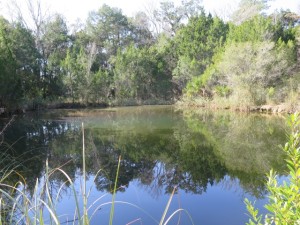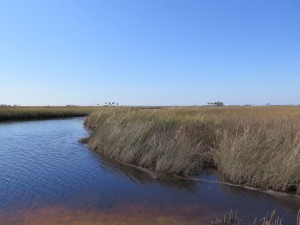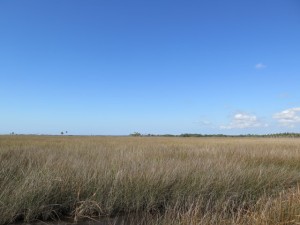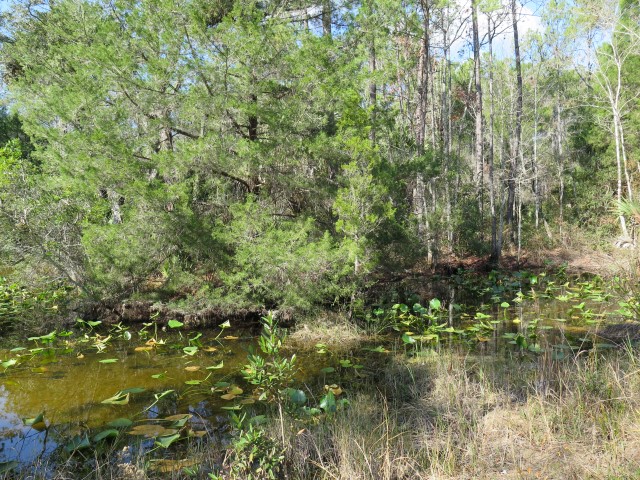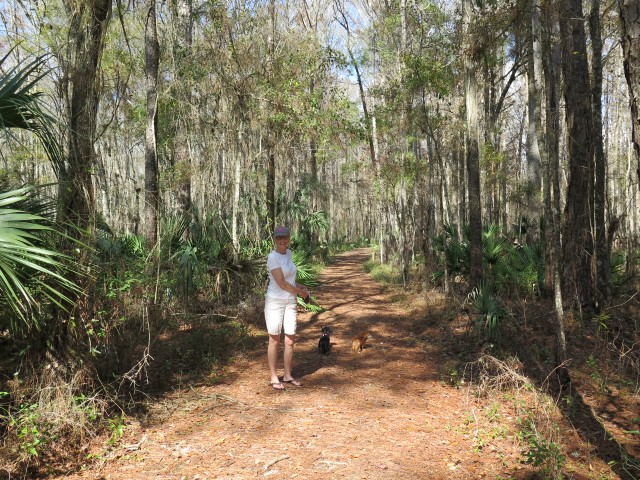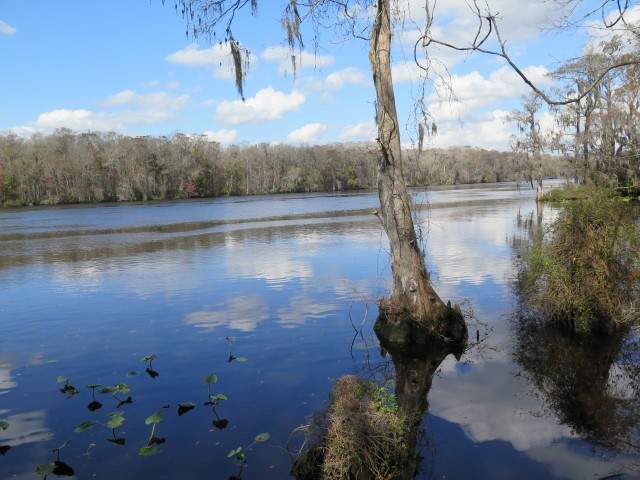Ah, the joys of a “learning experience.” The trip from LaGrange was completely uneventful until we decided to make a last-minute deviation from the dictates of the GPS-who-must-be-obeyed. Heading down I-75 to Exit 384 for Florida Highway 24, we saw a sign that announced “Exit 390: Truck Route to FL-26 and FL-24.” Truck route? That’s us. So, off we went. Well, I’m sure there were truck-suitable roads somewhere, but they were never beneath our wheels, especially not as we got routed onto a narrow (like 10-feet wide) horse farm path, crowded on both sides with huge oaks, with air-conditioner-eating branches looming merely inches above us. After we emerged 15 minutes later, Wendy and I tried to figure out the “lesson learned” from that little jaunt, and the best we could come up with is, “If the route looks wrong, STOP!” Seems kinda self-evident in hindsight, doesn’t it? Oh well, other than the terror factor, it was actually a pretty, and memorable, detour.
So we set up at Site #3 at Cedar Key RV Resort, relaxed for the afternoon, and readied ourselves for the stay.
Sunday (Jan 31): Off to Cedar Key proper, and an insight as to why traveling around, without an agenda or preconceived expectations, is so rewarding. The town of Cedar Key is hard to describe: a rural town that used to be a blue collar fishing village, trying to pull itself up by appealing to the tourist and artiste trades, with some success. In places. Mostly.
And then, in the midst our ambivalence, three (count ’em, three!) experiences that made the trip not only worth it, but recommended!
First, doing nothing but hang around the boat ramp, we watched a guy launch the strangest looking boat: open transom, with an outboard that dropped down through the center of the hull just aft of the helm. He and his buddy were donning wet suits, and we learned they were going out to “seed” clam beds, which caused us to research the activity. And here’s the story. In the 1990s, the government banned fishing with gill nets, supposedly out of concern for the welfare of dolphins, or turtles, or something, which wiped out the local fishing industry, thereby lowering the welfare of humans. (That trade-off is a topic for another day.) However, in a rare display of compassion for the human toll of such dictates, the government funded the start-up and retraining of fisherman to pursue “bivalve aquaculture” (i.e., clam and oyster farming). There are three phases to such farming. In the hatchery, fertilized eggs and free-swimming larval clams are reared under controlled conditions in large tanks filled with filtered, sterilized seawater, until they are about 1 mm long. Then, it’s off to a nursery, which can be either in tanks or raceways built on land, or in nets out in the bay, where the clams grow to 4 to 6 mm in size. Finally, the clams are placed in nets and taken to “grow-out” areas for 12 to 14 months where they grow to marketable size and are harvested. Each of the former, displaced fisherman was given the opportunity to lease two 2-1/2 acre plots out in the bay for rearing clams. The program has since expanded, allowing the fishermen an additional five acres. An excellent explanation of the process occurs on the Southern Cross Seafoods website. Southern Cross Seafoods also offers tours of their farms, although it looks like we won’t be able to make it. An item for the next trip.
Our research indicated that the aquaculture industry is, well, a hard way to make a living. Competition from large commercial operations, predation in the clam beds, the vagaries of weather and sea conditions, and fickle markets, all bear down on those trying to hang on. An article a few years ago from the Gainesville Sun explains the difficulties. Is clam farming a harder life than fishing? Who knows. But still, our encounter with this aspect of American life, fascinating in its complexity and implications, would never have occurred but for a side trip to a small town and a chance conversation with a local fisherman in an improbable boat.
Second, we stopped for lunch at Tony’s Seafood Restaurant for a bowl of clam chowder. Which wouldn’t warrant mention except that it’s the best clam chowder in the world. Really. In 2009, Chef Eric Jungklaus, owner of the restaurant, entered his clam chowder in the clam chowder world competition in Newport, Rhode Island. And he won. At ground zero of the blue-blooded, hoity-toity, clam chowder aristocrats, some guy from a small restaurant in a bitsy Florida town gave ’em all a good old Southern what-for! Then he entered again in 2010, and won again! And then he entered again in 2011, and won again! At this point, faced with wins three years in a row, the organizers “retired” the recipe and politely “excused” Chef Eric from further competition. And the chowder plainly deserves every accolade it gets; it’s not only rich and creamy (which is to be expected since it’s made from half-and-half and whipping cream), it has a spicy kick that lingers on the back of the tongue for a few seconds after every mouthful. It really is the best chowder in the world, and it can be ordered online. See the link above for more information. But the point is, how can this be? How can the best chowder in the world be found in a small restaurant, in an old building, in a barely hanging on small town? Because that’s the nature of this country, and such is why we travel.
Finally, Wendy and I enjoy learning about nature as we tour around. On our way back from Cedar Key, we spied a sign: “Florida Nature Coast Conservancy – Railroad Trestle Nature Trail.” So, off we went. The Florida Nature Coast Conservancy, as it turns out, is a small organization housed in Cedar Key with only five projects to its credit. But sometimes only the locals can focus on preservation opportunities too small for others to notice. Such as an old railroad trestle. A railroad line once ran from Fernandina, across Florida, to Cedar Key. The first train arrived in Cedar Key on March 1, 1861. Daily passenger and freight services from Fernandina Beach continued until the early 1880s when the railroad bypassed Cedar Key for the larger port of Tampa. Service to the island gradually declined until the last train departed from Cedar Key on July 7, 1932. But in the 80+ years since the railroad ceased operations, the course of the railroad line grew back to its natural condition. And now one can stroll along the former lines where the Conservancy has placed dozens of small signs, each carefully explaining what the plant is, where it grows, and what it can be used for. Think of the effort and care that went into that little project. Wonderful.
Monday (Feb 1): Many years ago, Wendy and I met a couple who did their RV travels along the lines of one theme for each trip: the best state parks for one circumnavigation, but also less obvious things like minor league baseball parks, presidential libraries or birthplaces, or civil war battlefield monuments. But one of their themes struck a chord: small, local museums. As they explained it to us, they discovered that there are hundreds of top-notch museums, mostly dedicated to local history or specialized themes. I recall their mentioning the Buffalo Bill Museum in Cody, Wyoming, and the Boy Scout Museum in Dallas, Texas, both of which are on our lists. So, we added to our travel ambitions the idea that we would seek out local museums wherever we happen to be.
So, this morning we headed off on our bikes and, after a brief stop at the Cedar Key Cemetery and park, made our way to the Cedar Key Museum State Park.
The museum itself is very nice. Small, but with a full history of the Cedar Key area and a wonderful collection of shells from all over the world. Two things made the museum worth the $2 admission fee. First, the significance of places, like people, often derives from both where they’ve come from and where they’re going. We understood better now the Cedar Key psyche knowing that Cedar Key once operated as one of the principal ports for trade with Mexico, Central, and South America. But second, like the clam farming encounter, travel forces one to realize how much he doesn’t know, how much goes on in the world every day that he just never thought about. An example: pencils. In the 1800s, Cedar Key supported a thriving operation supplying cedar for the A.W. Faber (later Eberhard Faber) pencil factory in New Jersey. And the other part of the pencil, the graphite core, came from graphite mines in, believe it or not, Siberia (!), where Faber had managed to lock in a lucrative (!) graphite supply contract. The graphite went from the Siberian mine, 300 miles by train, to Irkutsk, and then by ship to New Jersey. All of that for a pencil? So now we found ourselves back to online research, once again captivated by the complexity and, in a sense, the beauty of the networks that operate under our very noses.
Tuesday (Feb 2): The Lower Suwanee National Wildlife Refuge, 53,000 acres of estuaries, swamps, pine lands, and hardwood, is different than many wildlife preserves in that it’s managed for user friendliness. Even to the point of having a nine-mile, meandering road through the NWR that allows visitors to see the full range of habitats present in this area. So, we packed a picnic lunch and headed off, taking our time to explore the area.
But first, a digression: the NWR exists without going too far in two of the ways in which I sometimes diverge from my environmentalist friends. First, environmentalists often take humans out of the equation, as if there’s “nature” and there’s “mankind.” One sees it in expressions that human activities are “unnatural.” Environmentalists go too far, probably for the same reason, in supposing that the way to respect nature is to make it inaccessible to humans. Although there were a few areas in the NWR that were off limits, the ranger we spoke to encouraged us to drive the roads, hop the fences, walk the back country. In short, the refuge seems to say, “You are part of this. Come see it, and experience it, and in the process you will learn about yourself.” Second, environmentalists often take the easy road to preservation and conservation: passing restrictions on human activity without having to pay the full costs of what they extract from others. That seems to be less so at the Lower Suwanee NWR: much of the land was purchased, fair and square, by the Nature Conservancy and then donated to the Fish and Wildlife Service for the NWR. On both counts, this is a place that welcomes humans and we were glad to be there.
Back to our regularly scheduled programming … Along “Cabin Road,” one of the roads that branches off from the Lower Suwanee Nature Drive:
Out to the McCormick Creek estuary, a huge expanse of sawgrass (I think) that seems so out of place that one wonders if it were dropped from outer space.
Further up the nature road, one of dozens of ponds:
And eventually up to the visitor center and NWR headquarters, where, after having lunch at the rangers’ picnic table, we headed out on the River Trail:
To the Suwanee River itself:
I know that the rap on Florida is that it’s largely populated by despoiling corporate profiteers and land developers, all of whom are the environmental equivalent of serial rapists. That certainly doesn’t seem to be the case in this area of Florida. The area is largely unspoiled and manifests a deep concern for the importance of the natural order. It is as worthy a place as any we’ve seen in the Southeast to truly appreciate the beauty of God’s creation.
Tomorrow we head off to Sarasota, but knowing that there’s much still we want to do in Cedar Key: kayaking out to the keys, sampling the restaurants, visiting the historical society, touring the clam farming facility, and further exploring the NWR, including the Shell Mound area and the mouth of the Suwanee River. We’ll definitely be back.

